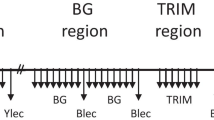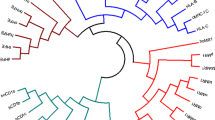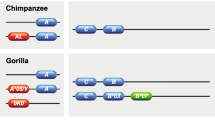Abstract
The major histocompatibility complex (Mhc) is a group of loci coding for lymphocyte membrane glycoproteins that provide the context for the recognition of foreign antigens in the initial phase of the immune response. The complex contains a large number of loci, some of which are highly polymorphic. The complexity and polymorphism pose a number of questions concerning the evolution of the Mhc. In an attempt to answer some of these questions, we have begun to study the Mhc of the mole-rat, Spalax ehrenbergi, a rodent representing a complex of sibling species occupying ecologically and geographically clearly delineated regions within the borders of Israel. In an earlier publication we identified the Spalax major histocompatibility (Smh) complex serologically and biochemically. Here, we analyze the Smh by Southern blotting of DNA fragments produced by restriction enzyme digestion. The fragments were hybridized to mouse probes specific for class I, class II, and C4 genes. The analysis has revealed that the Smh complex contains as many class I genes as the mouse does and that these genes are polymorphic. The number of class II genes could not be determined with certainty, but it is probably not greater than in the mouse. Polymorphism was also detected at the loci coding for the complement component 4 (C4), which are probably closely linked to the Smh complex. The polymorphism of mole-rat class I loci contrasts with the reported monomorphism of these loci in the Syrian hamster. Since the mole-rat leads a solitary, subterranean life, as the Syrian hamster does, ecology cannot be an explanation for the lack of class I polymorphism in the latter species.
Similar content being viewed by others
References
Adler, S. and Theodor, O.: Investigations on Mediterranean Kala Azar. II. Leishmania infantum. Proc. R. Soc. Lond. Biol. 108: 453–463, 1931
Bodmer, J. G. and Bodmer, W. F.: Histocompatibility 19804. Immunol. Today 5: 251–254, 1984
Brégégere, F., Abastado, J. P., Kvist, S., Rask, L., Lalanne, J. L., Garoff, H., Cami, B., Wiman, K., Larhammar, D., Peterson, P. A., Gachelin, G., Kourilsky, P., and Dobberstein, B.: Structure of Cterminal half of two H-2 antigens from cloned mRNA. Nature 292: 78–81, 1981
Cami, B., Brégégere, F., Abastado, J. P., and Kourilsky, P.: Multiple sequences related to classical histocompatibility antigens in the mouse genome. Nature 291: 673–675, 1981
Darden, A. G. and Streilein, J. W.: Syrian hamsters express two monomorphic class I major histocompatibility complex molecules. Immunogenetics 20: 603–622, 1984
Davis, M. M., Cohen, D. I., Nielsen, E. A., Steinmetz, M., Paul, W. E., and Hood, L.: Cell-type-specific cDNA probes and the murine I region: The localization and orientation of A dα . Proc. Natl. Acad. Sci. U.S.A. 81: 2194–2198, 1984
Festing, M.F.W. (ed.): International Index of Laboratory Animals, Medical Research Council, Laboratory Animals Centre, United Kingdom, 1981
Hood, L., Steinmetz, M., and Malissen, B.: Genes of the major histocompatibility complex of the mouse. Annu. Rev. Immunol. 1: 529–568, 1983
Klein, J.: Evolution and function of the major histocompatibility system: Facts and speculations. In D. Götze (ed.): The Major Histocompatibility System in Man and Animals, p. 339, Springer, Berlin, Heidelberg, New York, 1977
Klein, J. and Figueroa, F.: Polymorphism of the mouse H-2 loci. Immunol. Rev. 60: 23–57, 1981
Klein, J., Figueroa, F., and Nagy, Z. A.: Genetics of the major histocompatibility complex: The final act. Annu. Rev. Immunol. 1: 119–142, 1983
Nevo, E.: Observations on the Israeli populations of the mole rat Spalax ehrenbergi. Nehring 1898. Mammalia 25: 127–144, 1961
Nevo, E.: Speciation in subterranean mammals. In C. Barigozzi (ed.): Mechanisms of Speciation, p. 191, Alan R. Liss Inc., New York, 1982
Nevo, E.: Speciation in action and adaptation in subterranean mole rats: Patterns and theory. In Animal Speciation and Contact Zones. Proc. Symp. Pop. Genet. Ecol. (Bari, Italy, October 1982), Boll. Zool., in press, 1985
Nevo, E. and Bar-El, H.: Hybridization and Speciation in fossorial mole rats. Evolution 30: 831–840, 1976
Nižetić, D., Figueroa, F., Müller, H. J., Arden, B., Nevo, E., and Klein, J.: Major histocompatibility complex of the mole rat. I. Serological and biochemical analysis. Immunogenetics 20: 443–451, 1984
Ohno, S. and Wallace, W. B.: Polymorphism and monomorphism in class-I MHC antigens. Immunol. Today 4: 320–322, 1983
Orr, H. T.: Use of Southern blotting to analyze the size and restriction fragment polymorphism of HLA class I DNA in the human population. Transplant. Proc. 15: 1900–1906, 1983
Palmer, M., Wettstein, P. J., and Frelinger, J. A.: Evidence for extensive polymorphism of class I genes in the rat major histocompatibility complex (RT1). Proc. Natl. Acad. Sci. U.S.A. 72: 1184–1188, 1983
Southern, E. M.: Detection of specific sequences among DNA fragments separated by gel electrophoresis. J. Mol. Biol. 98: 503–517, 1975
Steinmetz, M., Minard, K., Horvath, S., McNicholas, J., Frelinger, J., Wake, C., Long, E., Mach, B., and Hood, L.: A molecular map of the immune response region from the major histocompatibility complex of the mouse. Nature 300: 35–41, 1982
Streilein, J. W. and Duncan, W. R.: On the anomalous nature of the major histocompatibility complex in Syrian hamsters, Hm-1. Transplant. Proc. 15: 1540–1545, 1983
Tosi, M., Levi-Strauss, M., Duponchel, C., and Meo, T.: Sequence heterogeneity of murine cDNA related to the C4 and C4-Slp isoforms of the fourth complement components. Philos. Trans. R. Soc. London Biol. 306: 386–394, 1984
Wahrman, J., Goitein, R., and Nevo, E.: Geographic variation of chromosome forms in Spalax, a subterranean mammal of restricted mobility. In K. Benirschke (ed.): Comparative Mammalian Cytogenetics, p. 30, Springer, New York, 1969a
Wahrman, J., Goitein, R., and Nevo, E.: Mole rat Spalax: Evolutionary significance of chromosome variation. Science 164: 82–84, 1969b
Yerganian, G.: History and cytogenetics of hamsters. Prog. Exp. Tumor Res. 16: 2–41, 1972
Author information
Authors and Affiliations
Additional information
On leave from the Department of Physiology, University of Zagreb Medical Faculty, Zagreb, Yugoslavia.
Rights and permissions
About this article
Cite this article
Nižetić, D., Figueroa, F., Nevo, E. et al. Major histocompatibility complex of the mole-rat. Immunogenetics 22, 55–67 (1985). https://doi.org/10.1007/BF00430594
Received:
Issue Date:
DOI: https://doi.org/10.1007/BF00430594




